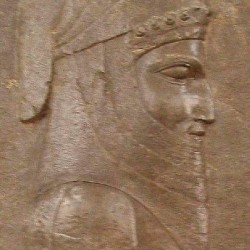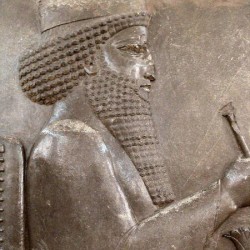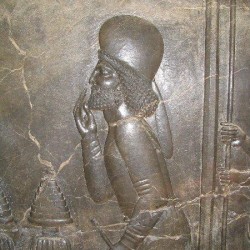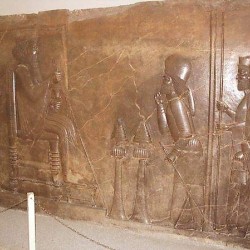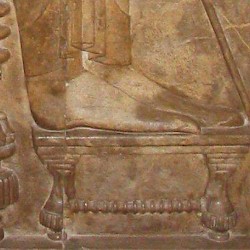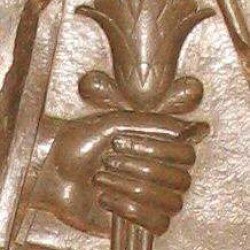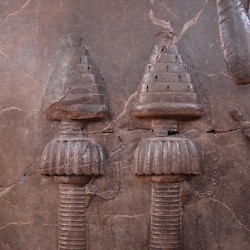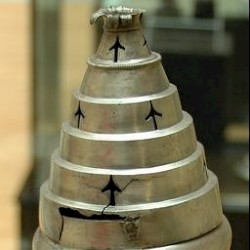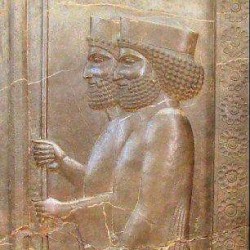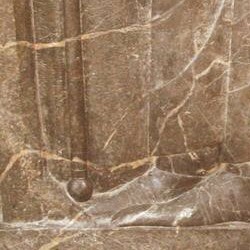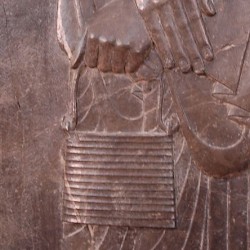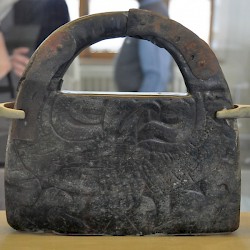Persepolis, Apadana, North Stairs, Central Relief
Persepolis (Old Persian Pârsa, modern Takht-e Jamshid): Greek name of one of the capitals of the ancient Achaemenid Empire, founded by king Darius the Great (r.522-486 BCE). There were several satellite sites, Naqš-e Rustam and Takht-e Rustam.
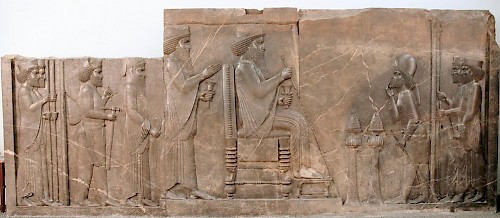
The relief that once graced the northern stairs of the Apadana at Persepolis is one of the most important examples of Achaemenid art. It shows a king receiving an important official, who performs the ritual greeting that is known as proskynesis. Several figures are standing to the left and right.
The relief has a remarkable history. Originally part of the northern stairs of the Apadana, it was later removed and set up in the Treasury. Here, it was discovered by the archaeologists who excavated Persepolis. They also found a similar relief, which once was part of the eastern stairs.
It is not known why these reliefs were removed. The northern relief is now in the National Archaeological Museum of Tehran; the eastern relief is still in the Treasury.
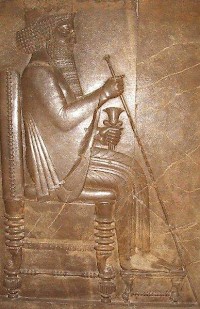
The relief shows a king sitting on a throne. He is often called Darius the Great (r.522-486), but in fact, we are not entirely certain about the identification. The people of the ancient Near East were not really interested in lifelike portraits, and perhaps it is better to interpret the man on the throne as a more abstract concept, not individual great king - the embodiment of monarchy.
On the other hand, the original relief was probably commissioned by Darius, so we may as well call the man Darius. Behind him is another important person, the crown prince. If we accept that the king is Darius, this man must be his son Xerxes. The man saluting the king is probably the major of the palace, Pharnaces. He announces the arrival of the tribute bearers, who are represented on the wall near the stairs.
Several scholars don't think that the man on the throne is an abstract king or Darius the Great, but represents Xerxes. Their argument is that the northern stairs were built by this king. In view of the fact that the relief on the eastern stairs is almost identical, this seems a bit far-fetched, but the theory does explain why the reliefs were taken away and brought to the Treasury. Xerxes was assassinated by his courtiers, and some of them were represented on the relief. His son and successor Artaxerxes I Makrocheir could not destroy the portrait of his father, but "punished" the murders by removing them to the Treasury.
However this may be, the man on the throne - we shall continue to call him Darius - is shown as the great king, and everything suggests his majesty. For example, he has a pleasant smelling flower in his hand. The crown prince is the only one who has the same prerogative. If this flower is a lotus, it may symbolize eternity: the flower has twelve petals, the number of months in a year.
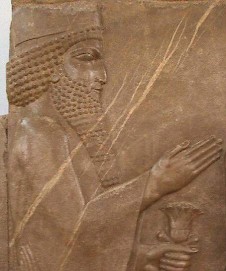
The king's feet don't touch the earth. From literary sources like Plutarch's biography of Alexander the Great, we know that the stool was an important attribute. Besides, the king is the only one who is sitting; he is also larger than the others. His shoes are finer than those of his courtiers. In front of the king are two standards, which can be identified with incense burners because these objects have actually been found in the Lydian town of Usak in Turkey. Again, a pleasant smell accompagnied the king.
The ultimate tribute: the great king is the only one who is shown with his successor. The succession of all the others depended on the king's will - only the ruler himself knew who would succeed his father - but the king himself could never be certain about his successor. The crown prince, with a flower, is pointing at his father and is, of all the standing figures, the tallest. This may or may not have something to do with the crown prince's official title mathišta, "the largest" (after the king, of course). If the man on the throne is Darius, this should be Xerxes - but their faces are identical.
There are several other people on this relief. Pharnaces, who announces the arrival of the tribute bearers, performs the ritual greeting that is known as proskynesis: he blows a kiss to the king. People of lesser stature had to bow or prostrate themselves for the representative of Ahuramazda on earth. As mayor of the palace or vizier (hazarapatiš), Pharnaces was entitled to a walking stick and golden earrings.
He is followed by two soldiers, not in battle dress. One of them carries an object that resembles a small bag. A similar object has been found in Iranian Azerbaijan. It was, rather remarkably, made of stone. Its function is unknown although it may have been a standard weight. An alternative hypothesis is that this man carries small coals of incense for the burner in front of the king.
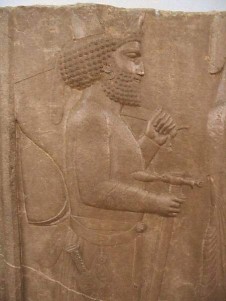
The two soldiers can be identified with the elite troops that the Greeks called Immortals or "apple bearers". They owed this remarkable surname to the fact that the metal counterweight of their spears had the shape of an apple. These "apples" were covered with silver or gold; to protect them, the soldiers placed their spears on the tip of their shoes.
The first man behind the crown prince (shown above) has a turban that can be identified as the cap of one of the Magians, the sacrificial specialists of the Persian empire. He is probably the Masmoghân, the chief Magian and supreme religious leader of ancient Iran, who had, according to a very late tradition, his residence in Rhagae. The lower part of the turban can be put before the mouth, so that the Magian would not pollute the sacred fire with his breath. From the holy book of Zoroastrianism, the Avesta, we know that the felt turban was called pâdam.
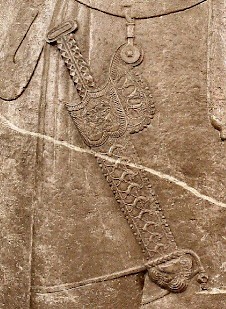
The next man is the king's weapon carrier. This was an important function. On the Behistun relief, a nobleman named Intaphrenes is depicted as the king's bow carrier; later, an aristocrat named Gobryas carried the royal spear (according to the relief on Darius' tomb at Naqš-e Rustam). The man on the northern stairs of the Apadana at Persepolis carries Darius' bow and battle axe. He is dressed like a cavalry man. On his belt, the weapon carrier has a short daggerlike sword in a beautiful scabbard. According to the Greek researcher Herodotus of Halicarnassus, this type of sword was called akinakes.note
Finally, to the left, there were two guardsman.
